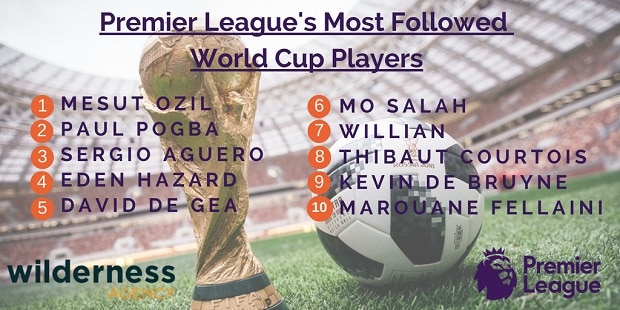
An estimated global audience of 3.4 billion, almost half the total world population, will provide the platform for players to enhance their off-field value as influencers and brand champions.
Research by Pitchside, the new sports division of Wilderness Agency, shows that Premiership playing squads are now twice as powerful as their clubs as influencers. With 108 players from the 20 league clubs representing 28 countries in the competition, including 21 of the 30 most followed stars with a combined reach of almost half a billion, that is gap is certain to increase.
And if England are long odds to win the World Cup, individual members of the squad also have their work cut out if they want to make the Top Ten most followed Premier League players appearing at the competition, a list completely made up of foreign stars.
Tom Jarvis, founder and Managing Director of the agency, said: “Social media has played a huge part in the evolution of the beautiful game allowing players to become the most powerful brands in football with the ability to engage directly with millions of fans across the globe on a daily basis. They are showcasing their lifestyle, fashion, training regime and details of the off-pitch lives to connect with fans at a very different level to that of clubs.
“We carried out the largest ever study of social media activity of the top 400 Premier League players’ and clubs’ Facebook, Twitter and Instagram profiles to reveal the most influential accounts. Our new metric, the ‘Social Player Index’ (SPI) reveals that players hold 2.38x more power and influence than their clubs. On the primary channel, Instagram, the aggregate following of the 20 most followed players in each of the 20 Premier League clubs reaches a total of 361.2 million, almost six times as many as the official social channels of the clubs at 62.6 million.
“Players are building vast audiences through their personal content creation, driving valuable conversation with fans and increasing their off-pitch value, and the global focus on them at the World Cup will only see this increasing.”
A table of the Top 10 most influential players appearing at the World Cup shows how they divide their posts between club and country, performance, brand and lifestyle.
Mesut Ozil of Arsenal and Germany has the most overall social media followers in the Premier League with more than 70 million. Of his 197 Instagram posts over the last 12 months, 47% were related to his club and 15% to his national side, 15% on performance, 20% to lifestyle and 3% to brand.
On Instagram alone, the most popular channel for players, he is surpassed by Paul Pogba of Manchester United and France, who is the top user with 218 posts over the last year, 27% are about his club, 6% about his national team, 39% about performance, 12% to brand and 16% on lifestyle. He has shown that frequency is key to maintaining influence and brand value.
Pogba, who has an aggregate social media following of ~35 million, is one of just five players in the top ten most followed Premier League players at the World Cup who has posted over 200 times over the last year.
Despite Pogba’s reported £33million deal with Adidas (which demands regular posts publicising the partnership) the importance of personal brand is king. Many of his posts are centred around other players, training and his personal performance, providing his fans with real-time insight and opportunities for engagement.
Clubs rely on their players to be able to post personable content on social media, so they are investing in players who can attract brand value and boost social media followers, as epitomised with Pogba’s £89m transfer to Man Utd in 2016.
None of the Top 30 Most Followed Premiership Players feature in the England squad.
Tom Howgate, former Commercial Director at Manchester United and Founder of Pitch side, said:
“Our first Premier League Social Player Index is the most in-depth independent social media analysis in football. It proves that Premier League footballers have become brands.
“However, the World Cup goes beyond personal brand identity and our report shows the impact that footballers can have on a brand’s bottom line – particularly when strong and relevant brand partnerships are created. Many brands are now understanding the power that footballers have and the value that is driven through the ability to connect direct to fans through them.”
Methodology:
Wilderness developed a social media index of the Top 400 Premier League players from the 2017/18 playing squads. They analysed the players and clubs’ official social media accounts across Facebook, Twitter and Instagram. Follower numbers were captured during the period February-April 2018. Activity numbers are taken from player lifetime activity on the platform.
The Social Player Index revealed players have power of Premier League squads is 2.38x that of their clubs.
Pitchside’s Premier League ‘Social Player Index’ (SPI) provides the most in-depth independent analysis of player social media activity ever undertaken. It also includes the Player Power Quotient (PPQ) – a measure of how the aggregate player social media following in each club compares against the number of followers of the club’s official social media channels over the 2017/18 season.
Premier League playing squads have an average of 2.38 times more followers than their clubs and fans are more likely to follow players whose content is more personable and provides an insight into their lifestyle.
